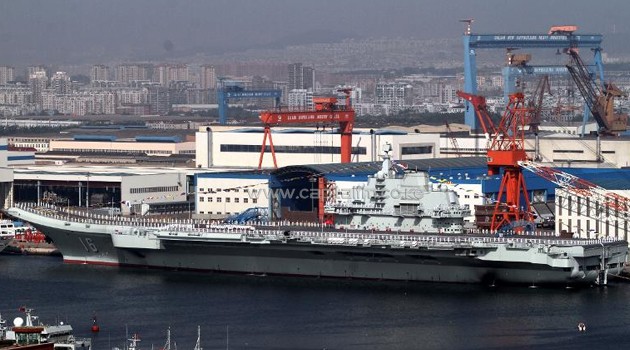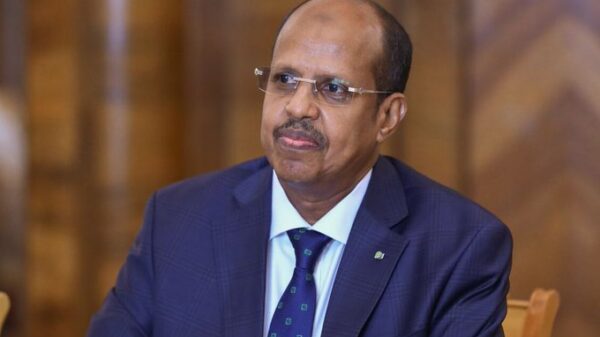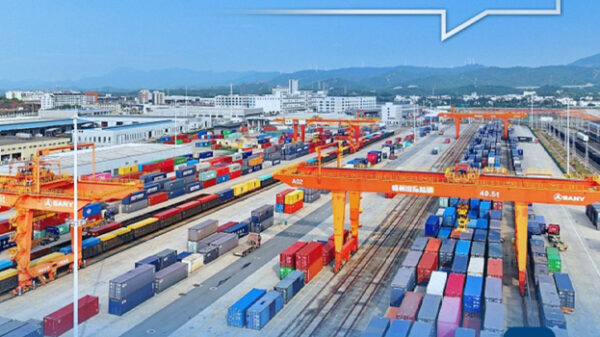
The Liaoning, China’s first aircraft carrier, sits berthed at the naval base in Dalian, Liaoning province in September 2012/AFP
QINGDAO, Apr 7 – China will show off its new aircraft carrier to US Defence Secretary Chuck Hagel on Monday, allowing the Pentagon chief a first hand look at a symbol of the country’s growing military prowess.
Hagel arrived in the port city of Qingdao to kick off a three-day tour of China with a visit to the carrier at Yuchi naval base. He will be the first foreigner allowed aboard the vessel by the often secretive Chinese People’s Liberation Army (PLA), officials said.
The carrier visit was “significant” as Washington has tried to forge a dialogue with China’s top brass to defuse tensions and prodded Beijing to be more open about its military, said a senior US defence official.
“We requested this and they agreed,” said the official, who spoke on condition of anonymity.
The carrier, the Liaoning, “symbolises for the PLA their ambition to project naval power,” the official said.
Upon arrival in Qingdao, Hagel was greeted by Chinese military officers and US ambassador Max Baucus.
The Liaoning was a Soviet-made warship based in Ukraine that the Chinese bought and refitted, completing the work in September 2012 in a symbolic milestone for the country’s expanding military.
China also reportedly has started constructing the second of four planned aircraft carriers, amid plans to begin operating an air wing of about 30 planes off the Liaoning as early as next year.
Unlike American aircraft carriers, the Liaoning is not nuclear powered and has a shorter range, and it has no catapult system for launching aircraft but merely an inclined ramp.
The Liaoning nevertheless reinforces the image of China as a military power with global reach and could be used in confrontations with smaller countries that have territorial disputes with Beijing, analysts say.
The carrier also coincides with major investments in submarines, anti-ship missiles and other hardware designed to bolster China’s naval clout in an area once solely dominated by the American fleet.
Before travelling to China, Hagel warned Beijing against unilateral action to resolve territorial disagreements with its smaller neighbours, drawing a parallel with Russia’s incursion in Ukraine.
“You cannot go around and redefine boundaries, violate territorial integrity and sovereignty of nations by force, coercion and intimidation whether it’s in small islands in the Pacific, or large nations in Europe,” Hagel said on Sunday during a visit to Tokyo.
“So I want to talk to our Chinese friends about this.”
He said he would talk to the Chinese about “respect for their neighbours” and that as “a great power,” China has “great responsibilities.”
His blunt comments underscored a tougher line in recent months by the US government on China’s approach to territorial claims in the South China Sea and the East China Sea, after some Southeast Asian countries accused Beijing of intimidatory tactics.
While in Tokyo, Hagel promised to send two more missile defence ships to Japan and reaffirmed Washington’s military treaty commitments, seeking to reassure its longtime ally as Tokyo grapples with a tense dispute with Beijing over islands in the East China Sea.
The US ships would join five Aegis missile defence vessels already stationed in the area, and were part of an American strategic “rebalance” to the Asia-Pacific, officials said.
Hagel’s announcement follows the deployment of a second early warning US radar to Japan, P-8 maritime surveillance aircraft and plans to bring unmanned Global Hawk drones to the country.
Although Hagel said the US warships were being sent to help counter the threat posed by North Korea, the move also carried symbolic weight amid Japan’s tense stand-off with China over the East China Sea.
Tokyo scrambled military aircraft last month after three Chinese planes flew near Japanese airspace, the latest confrontation in the dispute.











































